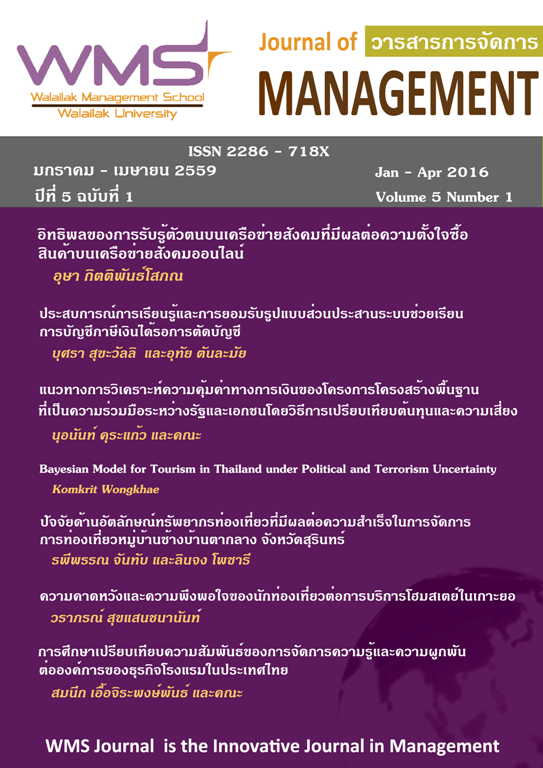Effect of Social Presence on Intention to Purchase in Social Network Environment
Main Article Content
Abstract
Article Details
References
กัลยา วานิชย์บัญชา. (2556). การวิเคราะห์สถิติ: สถิติสำหรับการบริหารและวิจัย. กรุงเทพฯ: ภาควิชาสถิติ คณะพาณิชยศาสตร์และการบัญชี จุฬาลงกรณ์มหาวิทยาลัย.
ยุทธ ไกยวรรณ์. (2556). การวิเคราะห์สถิติหลายตัวแปรสำหรับงานวิจัย. กรุงเทพฯ: สำนักพิมพ์แห่งจุฬาลงกรณ์มหาวิทยาลัย.
ข้อมูลรายได้ต่อหัว สัดส่วนอายุ โครงสร้างประชากรใน AEC. (2555). สืบค้นจาก http://www.thai-aec.com/37
Animesh, A., Pinsonneault, A., Yang, S.-B., & Oh, W. (2011). An odyssey into virtual worlds: exploring the impacts of technological and spatial environments on intention to purchase virtual products. MIS Quarterly-Management Information Systems, 35(3), 789-810.
Gefen, D. (2000). E-commerce: the role of familiarity and trust. Omega, 28(6), 725-737.
Gefen, D., Karahanna, E., & Straub, D. W. (2003). Trust and TAM in online shopping: An integrated model. Mis Quarterly, 27(1), 51-90.
Gefen, D., & Straub, D. W. (2004). Consumer trust in B2C e-Commerce and the importance of social presence: experiments in e-Products and e-Services. Omega, 32(6), 407-424.
He, J. (2011). Understanding the Sources and Impacts of Trust in E-Commerce: a Me-ta-Analysis. Paper presented at the AMCIS.
Hooper, D., Coughlan, J., & Mullen, M. (2008). Structural equation modeling: Guidelines for determining model fit. Electronic Journal of Business Research Methods, 6(1), 53-60.
Hoyle, R. H. (1995). Structural equation modeling: Concepts, issues, and applications. In R. H. Hoyle (Ed.), The structural equation modeling approach: Basic concepts and fundamental issues, (pp. 1-15). Thousand Oaks, CA: Sage Publications.
Hutter, K., Hautz, J., Dennhardt, S., & Füller, J. (2013). The impact of user interactions in social media on brand awareness and purchase intention: the case of MINI on Facebook. Journal of Product & Brand Management, 22(5/6), 342-351.
Jackson, D. L. (2001). Sample size and number of parameter estimates in maximum likelihood confirmatory factor analysis: A Monte Carlo investigation. Structural Equation Modeling, 8(2), 205-223.
Kehrwald, B. (2008). Understanding social presence in text‐based online learning environments. Distance Education, 29(1), 89-106.
Kim, E., & Zhang, R. (2014). Mediating role of initial trust on the relationship between website quality and purchase intention. Paper presented at the Association for Information Systems Conference, Macon, GA, USA.
Liang, T.-P., Ho, Y.-T., Li, Y.-W., & Turban, E. (2011). What drives social commerce: The role of social support and relationship quality. International Journal of Electronic Commerce, 16(2), 69-90.
Liang, T.-P., & Turban, E. (2011). Introduction to the special issue social commerce: a research framework for social commerce. International Journal of Electronic Commerce, 16(2), 5-14.
Liu, Z., Min, Q., & Liu, Z. (2014). The Impact of Perceived Interactivity On Individual Participation In Micro-Blogging. PACIS 2014 Proceedings, Paper69.
Lu, B., & Fan, W. (2014). Social Presence, Trust, and Social Commerce Purchase Intention: an Empirical Research. PACIS 2014 Proceedings, Paper105.
McKnight, D. H., & Chervany, N. L. (2001). What trust means in e-commerce customer relationships: an interdisciplinary conceptual typology. International Journal of Electronic Commerce, 6(2), 35-59.
Salam, A. F., Iyer, L., Palvia, P., & Singh, R. (2005). Trust in e-commerce. Communications of the ACM, 48(2), 72-77.
See-To, E. W. K., & Ho, K. K. W. (2014). Value co-creation and purchase intention in social network sites: The role of electronic Word-of-Mouth and trust–A theoretical analysis. Computers in Human Behavior, 31, 182-189.
Srivastava, M., & Kaul, D. (2014). Social interaction, convenience and customer satisfaction: The mediating effect of customer experience. Journal of Retailing and Consumer Services, 21(6), 1028-1037.
Tu, C.-H., & McIsaac, M. (2002). The relationship of social presence and interaction in online classes. The American journal of distance education, 16(3), 131-150.
Wu, J.-J., & Chang, Y.-S. (2005). Towards understanding members' interactivity, trust, and flow in online travel community. Industrial Management & Data Systems, 105(7), 937-954.


